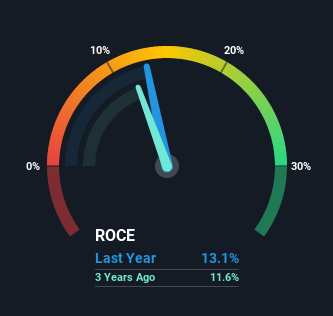- Hong Kong
- /
- Retail Distributors
- /
- SEHK:8126
Slowing Rates Of Return At G.A. Holdings (HKG:8126) Leave Little Room For Excitement
What trends should we look for it we want to identify stocks that can multiply in value over the long term? Amongst other things, we'll want to see two things; firstly, a growing return on capital employed (ROCE) and secondly, an expansion in the company's amount of capital employed. Put simply, these types of businesses are compounding machines, meaning they are continually reinvesting their earnings at ever-higher rates of return. So, when we ran our eye over G.A. Holdings' (HKG:8126) trend of ROCE, we liked what we saw.
Return On Capital Employed (ROCE): What is it?
For those that aren't sure what ROCE is, it measures the amount of pre-tax profits a company can generate from the capital employed in its business. To calculate this metric for G.A. Holdings, this is the formula:
Return on Capital Employed = Earnings Before Interest and Tax (EBIT) ÷ (Total Assets - Current Liabilities)
0.13 = HK$127m ÷ (HK$2.0b - HK$996m) (Based on the trailing twelve months to December 2021).
Thus, G.A. Holdings has an ROCE of 13%. In absolute terms, that's a satisfactory return, but compared to the Retail Distributors industry average of 8.8% it's much better.
See our latest analysis for G.A. Holdings

Historical performance is a great place to start when researching a stock so above you can see the gauge for G.A. Holdings' ROCE against it's prior returns. If you'd like to look at how G.A. Holdings has performed in the past in other metrics, you can view this free graph of past earnings, revenue and cash flow.
The Trend Of ROCE
While the current returns on capital are decent, they haven't changed much. The company has employed 69% more capital in the last five years, and the returns on that capital have remained stable at 13%. 13% is a pretty standard return, and it provides some comfort knowing that G.A. Holdings has consistently earned this amount. Over long periods of time, returns like these might not be too exciting, but with consistency they can pay off in terms of share price returns.
On a side note, G.A. Holdings' current liabilities are still rather high at 51% of total assets. This effectively means that suppliers (or short-term creditors) are funding a large portion of the business, so just be aware that this can introduce some elements of risk. Ideally we'd like to see this reduce as that would mean fewer obligations bearing risks.
What We Can Learn From G.A. Holdings' ROCE
In the end, G.A. Holdings has proven its ability to adequately reinvest capital at good rates of return. Yet over the last five years the stock has declined 47%, so the decline might provide an opening. For that reason, savvy investors might want to look further into this company in case it's a prime investment.
One final note, you should learn about the 2 warning signs we've spotted with G.A. Holdings (including 1 which is concerning) .
If you want to search for solid companies with great earnings, check out this free list of companies with good balance sheets and impressive returns on equity.
New: Manage All Your Stock Portfolios in One Place
We've created the ultimate portfolio companion for stock investors, and it's free.
• Connect an unlimited number of Portfolios and see your total in one currency
• Be alerted to new Warning Signs or Risks via email or mobile
• Track the Fair Value of your stocks
Have feedback on this article? Concerned about the content? Get in touch with us directly. Alternatively, email editorial-team (at) simplywallst.com.
This article by Simply Wall St is general in nature. We provide commentary based on historical data and analyst forecasts only using an unbiased methodology and our articles are not intended to be financial advice. It does not constitute a recommendation to buy or sell any stock, and does not take account of your objectives, or your financial situation. We aim to bring you long-term focused analysis driven by fundamental data. Note that our analysis may not factor in the latest price-sensitive company announcements or qualitative material. Simply Wall St has no position in any stocks mentioned.
About SEHK:8126
G.A. Holdings
An investment holding company, engages in the sale of motor vehicles and provision of car-related technical services in Hong Kong and the People’s Republic of China.
Moderate and slightly overvalued.
Market Insights
Community Narratives




